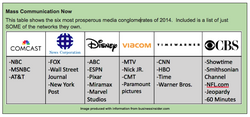Propaganda model
The model seeks to explain how populations are manipulated and how consent for economic, social, and political policies, both foreign and domestic, is "manufactured" in the public mind due to this propaganda.
Describing the media's "societal purpose", Chomsky writes, "... the study of institutions and how they function must be scrupulously ignored, apart from fringe elements or a relatively obscure scholarly literature".
Herman and Chomsky argue that since mainstream media outlets are currently either large corporations or part of conglomerates (e.g. Westinghouse or General Electric), the information presented to the public will be biased with respect to these interests.
The product is composed of the affluent readers who buy the newspaper—who also comprise the educated decision-making sector of the population—while the actual clientele served by the newspaper includes the businesses that pay to advertise their goods.
According to this filter, the news is "filler" to get privileged readers to see the advertisements which makes up the content and will thus take whatever form is most conducive to attracting educated decision-makers.
Stories that conflict with their "buying mood", it is argued, will tend to be marginalized or excluded, along with information that presents a picture of the world that collides with advertisers' interests.
Although British newspapers may occasionally complain about the "spin-doctoring" of New Labour, for example, they are dependent upon the pronouncements of "the Prime Minister's personal spokesperson" for government news.
The fourth filter is 'flak' (not to be confused with flack which means promoters or publicity agents), described by Herman and Chomsky as 'negative responses to a media statement or [TV or radio] program.
It may take the form of letters, telegrams, phone calls, petitions, lawsuits, speeches and Bills before Congress and other modes of complaint, threat and punitive action'.
An example is the US-based Global Climate Coalition (GCC), comprising fossil fuel and automobile companies such as Exxon, Texaco and Ford.
The GCC was conceived by Burson-Marsteller, one of the world's largest public relations companies, to attack the credibility of climate scientists and 'scare stories' about global warming.
Chomsky updated the model as "fear", often as 'the enemy' or an 'evil dictator' such as Colonel Gaddafi, Paul Biya, Saddam Hussein, Slobodan Milosevic, or Vladimir Putin.
The Sunday Times ran a series of articles in 1999 accusing activists from the non-violent direct action group Reclaim The Streets of stocking up on CS gas and stun guns.
[16] Chomsky also asserts that the media accurately covered events such as the Battle of Fallujah but because of an ideological bias, it acted as pro-government propaganda.
[20] Since the publication of Manufacturing Consent, Herman and Chomsky have adopted the theory and have given it a prominent role in their writings, lectures and theoretical frameworks.
[29] Both authors stated they felt the propaganda model is still applicable (Herman said even more so than when it was introduced), although they did suggest a few areas where they believe it falls short and needs to be extended in light of recent developments.
[33] Chomsky has commented in the "ChomskyChat Forum" on the applicability of the Propaganda Model to the media environment of other countries: That's only rarely been done in any systematic way.
[35] Studies have also expanded the propaganda model to examine news media in the People's Republic of China[36] and for film production in Hollywood.
[37] In July 2011, the journalist Paul Mason, then working for the BBC, pointed out that the News International phone hacking scandal threw light on close links between the press and politicians.
However, he argued that the closure of the mass-circulation newspaper News of the World, which took place after the scandal broke, conformed only partly to the propaganda model.
According to Lehrer, the fact that papers like The New York Times and The Wall Street Journal have disagreements is evidence that the media is not a monolithic entity.
[44] This was in response to Chomsky's assertion that in testing the Model, examples should be carefully paired to control reasons for discrepancies not related to political bias.
[44] Writing for The New York Times, the historian Walter LaFeber criticized the book Manufacturing Consent for overstating its case, in particular with regards to reporting on Nicaragua and not adequately explaining how a powerful propaganda system would let military aid to the Contra rebels be blocked.
LaFeber replied that: Mr. Herman wants to have it both ways: to claim that leading American journals "mobilize bias" but object when I cite crucial examples that weaken the book's thesis.
If the news media are so unqualifiedly bad, the book should at least explain why so many publications (including my own) can cite their stories to attack President Reagan's Central American policy.
[47]Chomsky responds to LaFeber's reply in Necessary Illusions: What is more, a propaganda model is not weakened by the discovery that with careful and critical reading, material could be unearthed in the media that could be used by those that objected to "President Reagan's Central American policy" on grounds of principle, opposing not its failures but its successes: the near destruction of Nicaragua and the blunting of the popular forces that threatened to bring democracy and social reform to El Salvador, among other achievements.


